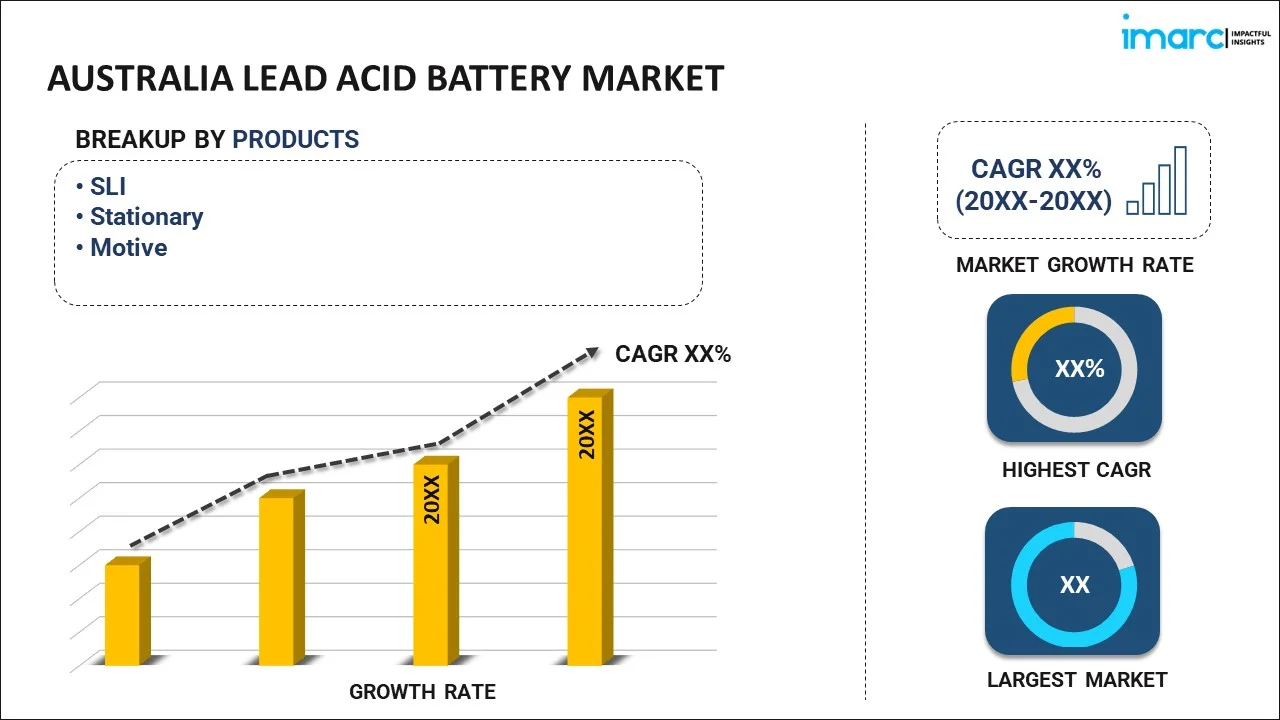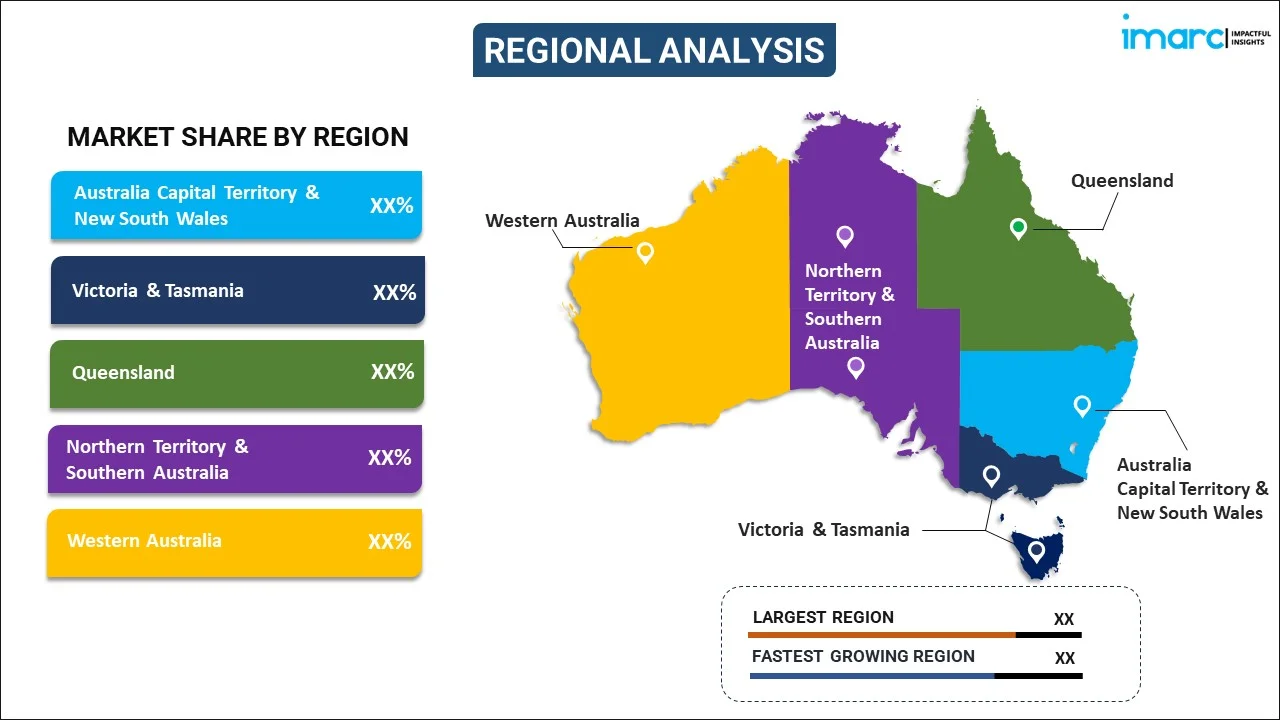
Australia Lead Acid Battery Market Report by Product (SLI, Stationary, Motive), Construction Method (Flooded, Valve Regulated Sealed Lead–acid Battery (VRLA)), Sales Channel (OEM, Aftermarket), Application (Automotive, UPS, Telecom, and Others), and Region 2025-2033
Market Overview:
Australia lead acid battery market size reached USD 591.3 Million in 2024. Looking forward, IMARC Group expects the market to reach USD 1,226.1 Million by 2033, exhibiting a growth rate (CAGR) of 7.80% during 2025-2033. The growth of the market is propelled by increasing demand in renewable energy storage, expansion of the automotive and marine sectors, and the need for reliable backup power in data centers and critical infrastructure.
|
Report Attribute
|
Key Statistics
|
|---|---|
|
Base Year
|
2024 |
|
Forecast Years
|
2025-2033
|
|
Historical Years
|
2019-2024
|
| Market Size in 2024 | USD 591.3 Million |
| Market Forecast in 2033 | USD 1,226.1 Million |
| Market Growth Rate (2025-2033) | 7.80% |
Lead acid batteries are a type of rechargeable battery that has been in use since the 19th century. They are primarily composed of lead dioxide (PbO2) as the positive plate, sponge lead (Pb) as the negative plate, and a diluted sulfuric acid (H2SO4) solution as the electrolyte. When the battery is in use, a chemical reaction occurs between these components, generating electrical energy. Lead acid batteries are known for their robustness, ability to withstand temperature variations and overcharging better than other battery types. They offer high discharge rates, delivering quick bursts of energy, ideal for applications like engine starting. These batteries are also relatively easy to maintain, with some types allowing electrolyte level checks and adjustments. They have a low self-discharge rate, making them suitable for seasonal or infrequent use. Additionally, their components are highly recyclable, with up to 95% being reclaimable, reducing their environmental footprint when managed responsibly. As a result, lead acid batteries are widely used for various applications ranging from starting, lighting, and ignition (SLI) in automobiles to backup power for uninterruptible power supplies (UPS) in data centers.
Australia Lead Acid Battery Market Trends:
One of the key factors driving the Australia lead acid battery market is the rising demand for reliable energy storage solutions, particularly in the renewable energy sectors such as solar and wind. As Australia invests more in sustainable energy sources, the need for cost-effective and dependable batteries for storing excess energy is surging, which, in turn, is creating favorable growth opportunities in the market. Another influential factor is the growth of the automotive industry. Due to the expansive geographical landscapes in the country, vehicles are essential for transportation, subsequently escalating the need for reliable SLI batteries. In addition to this, the rise in data centers and telecommunication infrastructure is augmenting the market growth. As Australia aims to bolster its digital economy, the establishment of data centers requires UPS to ensure constant operation. Lead acid batteries are often chosen for these UPS systems due to their proven reliability and relatively low upfront costs. Furthermore, Australia's critical infrastructure sectors, including hospitals, emergency services, and public utilities, necessitate dependable backup power systems, often employing lead acid batteries for their resilience and reliability. The marine industry, another vital sector in Australia due to its extensive coastline, also extensively uses lead acid batteries, further driving their demand. Besides this, Australia's robust recycling programs for lead acid batteries contribute to their appeal as an environmentally responsible choice. These recycling initiatives facilitate easier adoption by encouraging both consumers and industries to opt for a more sustainable energy storage option.
Australia Lead Acid Battery Market Segmentation:
IMARC Group provides an analysis of the key trends in each segment of the market, along with forecasts at the country level for 2025-2033. Our report has categorized the market based on product, construction method, sales channel, and application.
Product Insights:

- SLI
- Stationary
- Motive
The report has provided a detailed breakup and analysis of the market based on the product. This includes SLI, stationary, and motive.
Construction Method Insights:
- Flooded
- Valve Regulated Sealed Lead–acid Battery (VRLA)
A detailed breakup and analysis of the market based on the construction method have also been provided in the report. This includes flooded and valve regulated sealed lead-acid battery (VRLA).
Sales Channel Insights:
- OEM
- Aftermarket
The report has provided a detailed breakup and analysis of the market based on the sales channel. This includes OEM and aftermarket.
Application Insights:
- Automotive
- UPS
- Telecom
- Others
A detailed breakup and analysis of the market based on the application have also been provided in the report. This includes automotive, UPS, telecom, and others.
Regional Insights:

- Australia Capital Territory and New South Wales
- Victoria and Tasmania
- Queensland
- Western Australia
- Northern Territory and Southern Australia
The report has also provided a comprehensive analysis of all the major regional markets, which include Australia Capital Territory and New South Wales, Victoria and Tasmania, Queensland, Western Australia, and Northern Territory and Southern Australia.
Competitive Landscape:
The market research report has also provided a comprehensive analysis of the competitive landscape in the market. Competitive analysis such as market structure, key player positioning, top winning strategies, competitive dashboard, and company evaluation quadrant has been covered in the report. Also, detailed profiles of all major companies have been provided.
Australia Lead Acid Battery Market Report Coverage:
| Report Features | Details |
|---|---|
| Base Year of the Analysis | 2024 |
| Historical Period | 2019-2024 |
| Forecast Period | 2025-2033 |
| Units | Million USD |
| Scope of the Report | Exploration of Historical Trends and Market Outlook, Industry Catalysts and Challenges, Segment-Wise Historical and Future Market Assessment:
|
| Products Covered | SLI, Stationary, Motive |
| Construction Methods Covered | Flooded, Valve Regulated Sealed Lead–acid Battery (VRLA) |
| Sales Channels Covered | OEM, Aftermarket |
| Applications Covered | Automotive, UPS, Telecom, Others |
| Regions Covered | Australia Capital Territory and New South Wales, Victoria and Tasmania, Queensland, Western Australia, Northern Territory and Southern Australia |
| Customization Scope | 10% Free Customization |
| Post-Sale Analyst Support | 10-12 Weeks |
| Delivery Format | PDF and Excel through Email (We can also provide the editable version of the report in PPT/Word format on special request) |
Key Questions Answered in This Report:
- How has the Australia lead acid battery market performed so far and how will it perform in the coming years?
- What has been the impact of COVID-19 on the Australia lead acid battery market?
- What is the breakup of the Australia lead acid battery market on the basis of product?
- What is the breakup of the Australia lead acid battery market on the basis of construction method?
- What is the breakup of the Australia lead acid battery market on the basis of sales channel?
- What is the breakup of the Australia lead acid battery market on the basis of application?
- What are the various stages in the value chain of the Australia lead acid battery market?
- What are the key driving factors and challenges in the Australia lead acid battery?
- What is the structure of the Australia lead acid battery market and who are the key players?
- What is the degree of competition in the Australia lead acid battery market?
Key Benefits for Stakeholders:
- IMARC’s industry report offers a comprehensive quantitative analysis of various market segments, historical and current market trends, market forecasts, and dynamics of the Australia lead acid battery market from 2019-2033.
- The research report provides the latest information on the market drivers, challenges, and opportunities in the Australia lead acid battery market.
- Porter's five forces analysis assist stakeholders in assessing the impact of new entrants, competitive rivalry, supplier power, buyer power, and the threat of substitution. It helps stakeholders to analyze the level of competition within the Australia lead acid battery industry and its attractiveness.
- Competitive landscape allows stakeholders to understand their competitive environment and provides an insight into the current positions of key players in the market.
Need more help?
- Speak to our experienced analysts for insights on the current market scenarios.
- Include additional segments and countries to customize the report as per your requirement.
- Gain an unparalleled competitive advantage in your domain by understanding how to utilize the report and positively impacting your operations and revenue.
- For further assistance, please connect with our analysts.
 Inquire Before Buying
Inquire Before Buying
 Speak to an Analyst
Speak to an Analyst
 Request Brochure
Request Brochure
 Request Customization
Request Customization




.webp)




.webp)












